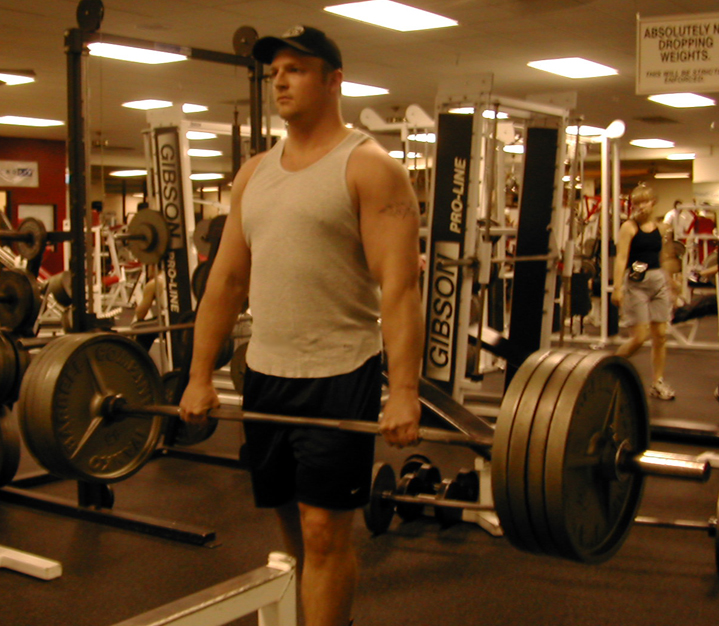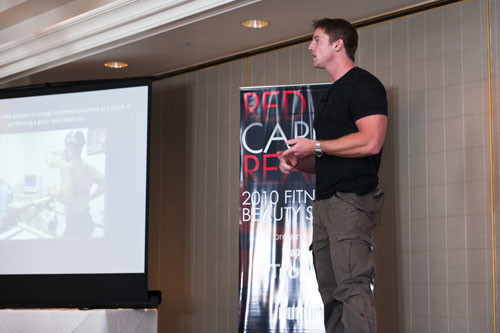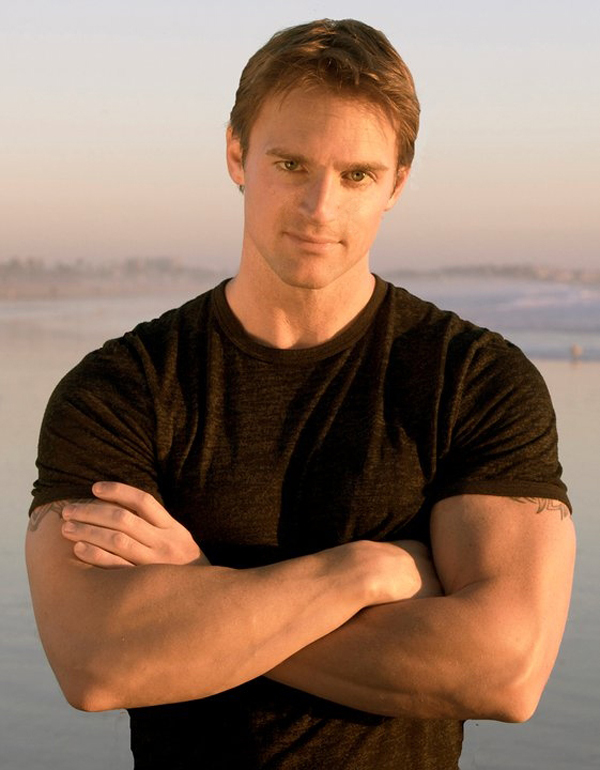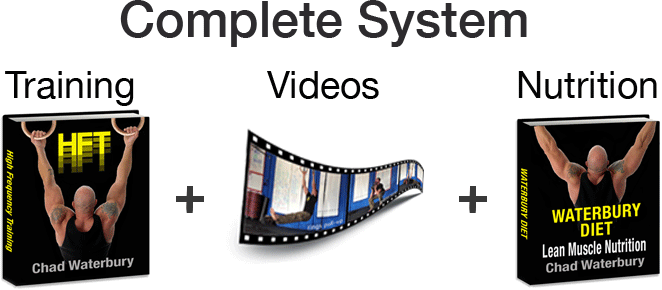CB: Chad, thanks for doing this interview. You’ve worked with many different clients over the years and one specialty you’re known for is muscle growth. Tell us more about that.
Chad: When I started training clients 17 years ago, most of my clients were guys who wanted to build muscle. Since they hired me, it was obvious they were hardgainers. So I had to quickly learn how to add muscle to them or else I would’ve had to find another profession.
Since then, I’ve worked with every type of guy you can imagine. One common factor is that they all want to build muscle fast. An athlete needs it to boost his performance, and a regular guy wants it so he can perform better in the gym and look better on the beach. In any case, when it comes to muscle growth, the laws of physiology don’t change based on what you do for a living.
CB: When muscle growth is slow, what’s usually to blame?
Chad: That’s a good question. Nutrition can certainly be a problem. I’ve found that stuffing your gut with protein powders every few hours can slow muscle gains by reducing protein synthesis. It can have a pro-inflammatory effect and this reduces muscle growth, recovery, and performance.
Most often, however, the problem lies within the person’s training parameters. You must shock the muscle with a powerful stimulus in order to make it grow. Sometimes the answer is to drastically increase your training intensity. Successful bodybuilders such as Mike Mentzer, Dorian Yates, and Ronnie Coleman have all extolled the benefits of high intensity training.
But there’s a major problem with following the high intensity approach popularized by professional bodybuilders: it doesn’t work for the vast majority of guys out there. If it did work, we’d all be following it.
CB: So what does work when a guy has a hard time building muscle?
Chad: That’s a question that’s taken me the better part of my career to figure out. When I was a young trainer I tried all the approaches you read about in muscle magazines. I’m sure your readers did, too. Virtually none of them worked to any respectable degree.
It wasn’t until 2001 when I saw the Alexis brothers perform their routine in Mystère in Las Vegas that I started to take a different approach to training my clients. Those guys have strength, athleticism, and physiques that anyone would commit a felony to have.

I knew the Alexis brothers had superb genetics, but when you consider that they were doing 10 shows per week with multiple practice sessions in between, it made sense to mimic what they did. At least it was worth a try.
Now, there were obviously two things they were doing that most hardgainers weren’t doing. First, they were training their muscles much more frequently than the typical two or three times per week bodybuilding routines. Second, their training was manageable from a recovery standpoint. It had to be because they were doing 10 shows per week.
When I got home I started training with a higher frequency because I was at a stage in my life when I wanted to be much bigger. So I ate everything in sight and doubled my training frequency. I worked my way up to 286 pounds. That’s a lot for me because my body wants to weigh around 195 pounds. I wasn’t ripped but I didn’t care at the time. The higher frequency of training shocked my body into growth.

I also started implementing high frequency training (HFT) protocols into my client’s programs to target stubborn muscle growth. So if my client had proportionally small arms, or pecs, or calves – any muscle group, really – I increased the frequency for training that muscle group up to 10 times per week.
CB: Wow, so they spent a lot of time in the gym.
Chad: Actually, they didn’t. I had them perform extra training sessions that only lasted a few minutes each day with dumbbell or body weight exercises. Sometimes I would prescribe pull-ups to a guy who had a pull-up bar at home, other times it would be an exercise that only required a dumbbell.
If I was going to have my clients train their muscles more frequently, I knew those extra mini-workouts couldn’t take much time or require trips to the gym. This is one aspect of HFT that I got right from the start.
Where I fell short was with the initial training parameters. Sometimes I would prescribe too much too soon. Other times I wouldn’t vary the movement pattern enough and their joints would get aggravated. This is why I no longer recommend daily pull-ups from a fixed bar. When the wrists are locked into place it puts excessive stress on the elbows and shoulders.
CB: What have you found are the keys to fast muscle growth?

Chad: First, train the stubborn muscle groups more frequently. You need at least four sessions per week with full-body training. And if it’s a specific muscle group like your biceps you should train it six or seven days per week.
Second, the initial training volume must be relatively low. It doesn’t take much work to turn on protein synthesis, but that stimulus must occur frequently throughout the week. No matter how hard you try you can’t get much growth from a single training session, or even in a day.
Look, as I’ve said numerous times, if 100 sets of curls in one day could add an inch to your biceps, every guy would’ve found time to do it. But it won’t work because there’s only so much growth you can stimulate in a day.
Now, if you increase that stimulus to six or seven times per week you’ll get much faster muscle gains. It’s simple math: more work will lead to more growth, provided your body can recover from the workout. This is why you should start with a low volume of work when you merge into HFT. You never want to do more than is required at first.
Third, there must be a steady progression plan in place. If you do 100 push-ups every day you’ll gain respectable mass within the first few weeks but then your growth will come to a halt.
Why? Because the body has already added all the muscle tissue it needs to adapt to the demand. You must make your muscles perform more work over time. Adding as little as one rep per day can do the trick.
For example, let’s say your pecs need more size and you do 50 push-ups per day to fix the problem. If you’re a 200-pound guy you’re pushing 150 pounds with each rep. By adding one rep per day you made those muscles do an additional 3150 pounds of work by the end of the first week. This added volume accumulates quickly. It’s like compounding interest for your muscles.
CB: And this is why High Frequency Training works so well?
Chad: Yes, when you start with the right exercises, volume, and progression plan, you can make any stubborn muscle add mass within four weeks. A properly designed HFT plan will build muscle faster than anything I’ve seen.
My new muscle-building system, High Frequency Training, takes all the guesswork out of the process. It contains 28-day plans for all major muscle groups if you just need to target undeveloped body parts. And it contains a 12-week full-body plan if you need to quickly add muscle across your entire body. Plus, a complete nutrition program and instructional videos are included.
It’s my best muscle-building system to date.
CB: Thanks Chad! If you’re a guy who feels over trained this could be a great change of pace plus a great way to add muscle fast. Click here to learn more about Chad’s new HFT program.
















































































wow!!!! alot of people tell me that I shouldn’t workout a muscle so much because i could hert myself & I lefting up weight & do go heavy because I like to feel the burn :)Am going to do what you say…. Work it out 7 times aweek but am going to do it 3 or 4 times aweek, because I go to the GYM 5 to 6 times aweek. So see what happens 🙂
THXZ…..
Beauty article Chad! I hear so often of people scared of “overtraining”. I mainly do Olympic lifting for most of my athletic power training and when running any kind of “Bulgarian” style cycle where we’re maxing out every day, me and the boys do see some impressive gains. I find that its in the dark days when you feel like your absolutely smashed to pieces, but manage to pull yourself together and finish your workout strong, these are the days that force the real gains, whether they be strength like in my case or a higher volume cycle like you mentioned. One way i always describe it to people is like you just started a new job shoveling rock all day, of course your gonna be sore and beat down for the first few days, maybe even week. but eventually your body adapts and you can hammer away all day every day at something that a few weeks previous put you one foot in the grave.
Hi there to every body, it’s my first payy a visit of
this webpage; this webpagfe carries ammazing and truly good information for readers.
Alsso visit my web site: Contoh Undangan Pernikahan
Thank you for the kind words! We work really hard to to provide intensive information to our readers and followers. 🙂